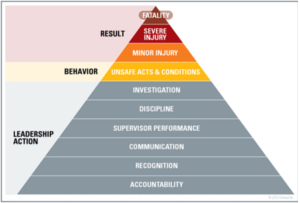Originally posted on Caterpillar Safety Service’s Safety Culture WORLD blog http://safetycultureworld.blogspot.com/ and reposted here with Caterpillar’s permission.
 H. W. Heinrich changed the world of safety fundamentals forever with his pioneering work in the 1930’. One of his concepts that continues to make me think is his accident triangle (pyramid), a concept that we all are familiar with.
H. W. Heinrich changed the world of safety fundamentals forever with his pioneering work in the 1930’. One of his concepts that continues to make me think is his accident triangle (pyramid), a concept that we all are familiar with.
So many near misses lead to a lesser number of first-aid injuries and thence onward through the logic to recordables and ending in the inevitability of a fatality.
This inevitability of disaster has always bothered me.
If I cross the railroad tracks too many times I will die, or drive to work, or something else like that.
I am not a fatalist, and thus my pondering is on what exists that will enable the industrial work place to overcome this fatalistic teaching.
My work with companies and individuals that have done both well and poorly in safety always leads to individual behaviors as a foundational key, after workplace conditions, training and safety standards are addressed.
In many cases, the “behavior foundation” appears to be made of sand. It is not a firm foundation on which to build a zero-injury culture. So how does one attack this foundation of the triangle? Years of thought and effort in this area have led to a whole different level of sub-foundation as shown below.

If our new safety triangle (pyramid) is built on the “stone foundation” of excellent fundamentals that modify behaviors and actions, can we limit (reduce) the base of improper activities that lead to 90+ percent of the injuries in Heinrich’s pyramid? Each time I have rebuilt the foundation, the results have been similarly excellent.
The following sub-foundation fundamentals significantly reduced injuries.
- Visible upper management leadership in safety
- Noticeable involvement of middle management
- Focused supervisory performance
- Active participation of hourly employees
Training that both teaches and reinforces this type of foundational excellence
The above principles tie in very well with the quality function’s 6-sigma initiative for significant improvement; DMAIC (define, measure, act, improve, control). Only in our safety case it is:
- Define the correct behaviors that eliminate unsafe acts and injuries
- Train all personnel in these behaviors
- Measure that they are indeed doing these correct behaviors
- Reward their accomplishments of these correct behaviors
The key then is not to focus on compliance, or reward “acceptable injury levels/goals,” or on any other single tactic approach. The key is to concentrate on the foundational fundamentals that eliminate the activities/behaviors that in turn move us out of the chance probability of the Heinrich inevitability triangle. We must error proof the fundamental safety processes and deliver safety accountabilities at each level of the organization. We then engage in a daily practice of the upstream activities that deliver downstream performance.


Recent Comments
In addition to the personal hardship and loss...
No one will know the answer to this...
Bad drivers don't have to ruin your day...
Healthcare workers face a number of serious safety...
In my experience, truck drivers are treated with...